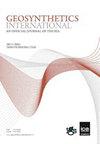Analytical solution for solute transport in a triple liner under non-isothermal condition
IF 3.3
2区 工程技术
Q2 ENGINEERING, GEOLOGICAL
引用次数: 5
Abstract
Analytical solutions for the transport of contaminant through a 1D triple-layer composite liner system consisting of a geomembrane (GMB), a geosynthetic clay liner (GCL) and a compacted clay liner (CCL) under non-isothermal conditions are derived using the generalized integral transform technique. The proposed analytical solutions account for the combined effects of molecular diffusion, sorption and thermodiffusion as well as the temperature-dependent distribution coefficient and effective diffusion coefficient. The proposed analytical solutions are successfully validated against the experimental results of thermodiffusion tests and verified against an analytical solution available in the literature and a numerical model based on commercial finite element software. Using the verified analytical solutions, simulations are performed with representative geometry and material properties for a GMB/GCL/CCL liner system. The results indicate that neglecting the effect of non-isothermal condition can underestimate the benzene outflow rate by over 30% when the temperature difference between the surface and bottom of the liner system exceeds 10 K. The temperature-dependent CCL effective diffusion coefficient and CCL distribution coefficient have significant effect on benzene transport through the GMB/GCL/CCL liner system, whereas the liner thermal conductivity and the temperature-dependent GCL effective diffusion coefficient and GCL distribution coefficient have a negligible effect.非等温条件下溶质在三重衬层中传输的解析解
利用广义积分变换技术导出了污染物在非等温条件下通过由土工膜(GMB)、土工合成粘土衬垫(GCL)和压实粘土衬垫(CCL)组成的1D三层复合衬垫系统传输的解析解。所提出的分析解考虑了分子扩散、吸附和热扩散的综合效应,以及与温度相关的分布系数和有效扩散系数。所提出的分析解与热扩散试验的实验结果进行了成功验证,并与文献中可用的分析解和基于商业有限元软件的数值模型进行了验证。使用经验证的分析解决方案,对GMB/GCL/CCL衬里系统的代表性几何结构和材料特性进行了模拟。结果表明,当内衬系统表面和底部的温差超过10K时,忽略非等温条件的影响会使苯的流出率低估30%以上。依赖于温度的CCL有效扩散系数和CCL分布系数对苯通过GMB/GCL/CCL衬管系统的输运有显著影响,而衬管热导率和温度依赖的GCL有效扩散因数和GCL分布系数的影响可忽略不计。
本文章由计算机程序翻译,如有差异,请以英文原文为准。
求助全文
约1分钟内获得全文
求助全文
来源期刊

Geosynthetics International
ENGINEERING, GEOLOGICAL-GEOSCIENCES, MULTIDISCIPLINARY
CiteScore
6.90
自引率
20.00%
发文量
91
审稿时长
>12 weeks
期刊介绍:
An online only, rapid publication journal, Geosynthetics International – an official journal of the International Geosynthetics Society (IGS) – publishes the best information on current geosynthetics technology in research, design innovation, new materials and construction practice.
Topics covered
The whole of geosynthetic materials (including natural fibre products) such as research, behaviour, performance analysis, testing, design, construction methods, case histories and field experience. Geosynthetics International is received by all members of the IGS as part of their membership, and is published in e-only format six times a year.
 求助内容:
求助内容: 应助结果提醒方式:
应助结果提醒方式:


